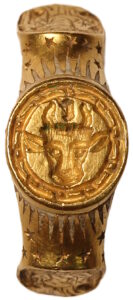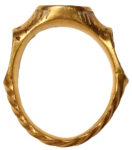A gold and enamel signet ring engraved with the head of a bull, emblem of the Boleyn family, has gone on display at Hampton Court Palace.
 The ring’s bezel is engraved with the head of a bull facing forward with large horizontal ears and vertical horns. Between the horns is a letter that is hard to make out. It could be an “e,” an “r” or a “t.” Solar rays filled with white enamel radiate down the shoulders of the bezel. On each shoulder is a flattened oval panel engraved with religious figures — Virgin and Child on one side, St. Catherine of Alexandria on the other.
The ring’s bezel is engraved with the head of a bull facing forward with large horizontal ears and vertical horns. Between the horns is a letter that is hard to make out. It could be an “e,” an “r” or a “t.” Solar rays filled with white enamel radiate down the shoulders of the bezel. On each shoulder is a flattened oval panel engraved with religious figures — Virgin and Child on one side, St. Catherine of Alexandria on the other.
The bull was on the arms of Thomas Boleyn, Anne’s father, and the arms of his son George. As with many signet rings, the iconography is probably canting, a play on the family name. In this case, “Boleyn” was often written as “Bullen,” which is why bull heads were incorporated into the family arms. They’re usually in profile, though. No other examples of a facing bull are known from Boleyn signatures or arms.
The find site is further evidence of the ring being connected to the Boleyn family. It was discovered in 2019 near Shurland Hall on the Isle of Sheppey, an island off the northern coast of Kent. Less than 50 miles east of Hever Castle, the Boleyn family seat where Anne was raised, Shurland Hall was one of the greatest estates in medieval Kent. The original 13th century castle was rebuilt between 1510 and 1518 by Thomas Cheyne, a relative of the Boleyns and a trusted courtier to every Tudor monarch from Henry VII to Elizabeth I. He was Sherriff of Kent, Justice of the Peace for Kent, Lord Ward of the Cinque Ports and also served as Treasurer of the Household, privy councilor and as ambassador to France three times.
 He was a particular favorite of Anne Boleyn’s who advocated successfully for his promotion before her marriage to Henry. In October 1532, Cheyne was singled out for the cripplingly expensive honor of hosting the royal couple and their retinue of hundreds. They spent three days at Shurland Hall on their way to Calais to secure the support of King Francis I of France for their marriage. Henry and Anne would marry in secret one month later.
He was a particular favorite of Anne Boleyn’s who advocated successfully for his promotion before her marriage to Henry. In October 1532, Cheyne was singled out for the cripplingly expensive honor of hosting the royal couple and their retinue of hundreds. They spent three days at Shurland Hall on their way to Calais to secure the support of King Francis I of France for their marriage. Henry and Anne would marry in secret one month later.
The ring is not thought to have belonged to Anne herself, due to the fact she bore her own arms after her marriage to King Henry VIII, with this signet ring also being a typically male item of jewellery which would have been too large for a woman. However, both Thomas and George held the title of Viscount Rochford from 1525 and 1529 successively, meaning that either man would have been entitled to bear the monogram for Rochford. The ring features an initial that could denote the letter R – further strengthening the claim that it has links to the two Boleyn men. […]

The religious symbolism may well also hold the key to the ring’s original owner, with St Catherine being known for her scholarly defence of her faith, and the choice of saint perhaps referring to Henry’s first wife, Katherine of Aragon. There is a possibility the ring may have alternatively belonged to another wealthy Tudor who bore the same badge, although this does not change the fact that is a remarkable piece of surviving jewellery from the era.
This exquisite object has been acquired by Historic Royal Palaces (HRP) – the charity that cares for Hampton Court Palace. It will now be shown to visitors in the Great Hall, which sits at the very heart of the surviving Tudor palace (the apartments built for Queen Anne Boleyn were lost in the 17th century). Home to the last great medieval hammerbeam roof hall in England, work began on the Great Hall began in 1532 to mark the King’s marriage to Anne Boleyn, with motifs relating to the new Queen incorporated into the design.